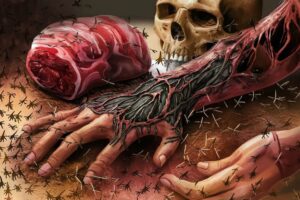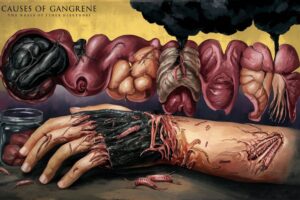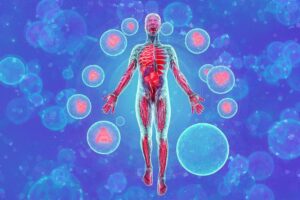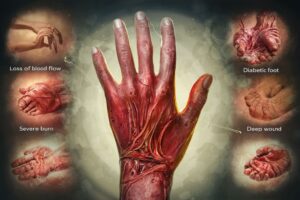What are the Causes and Symptoms of Gangrene Disease and How to Treat?
Gangrene is a serious medical condition that occurs when a part of the body loses its blood supply due to a lack of blood supply or a bacterial infection., leading to tissue death. Understanding the causes, symptoms, and treatment options for gangrene is crucial for early detection and intervention to prevent complications.
This article provides an in-depth exploration of various types and causes of gangrene, explores the symptoms and warning signs to look out for, discusses the diagnostic process, outlines treatment options available, suggests preventive strategies, and touches on the potential complications and prognosis associated with this condition.
By shedding light on gangrene, individuals can become more informed about this condition and take proactive steps towards maintaining their health and well-being.

Table of Contents
ToggleIntroduction to Gangrene Disease
Gangrene is a serious and potentially life-threatening condition that occurs when body tissue dies due to a lack of blood flow or a bacterial infection.
There are several types of gangrene, including dry, wet, and gas gangrene, each with its own causes and symptoms. Dry gangrene is usually caused by reduced blood flow to the affected area, while wet gangrene typically results from a bacterial infection. Gas gangrene is the most severe form of gangrene and is caused by a specific type of bacteria that produces toxins which destroy tissue.
Gangrene can affect any part of the body, but it is most commonly found in the fingers, toes, limbs, and internal organs. Symptoms of gangrene may include severe pain, swelling, redness, and a foul-smelling discharge from the affected area.
If left untreated, gangrene can lead to complications such as sepsis, which is a potentially life-threatening condition caused by the body’s response to infection. Treatment for gangrene usually involves surgical removal of the dead tissue, antibiotics to treat any infection, and measures to improve blood flow to the affected area.
Prevention of gangrene involves good hygiene practices, prompt treatment of wounds or injuries, and managing underlying health conditions such as diabetes or peripheral artery disease.
It is important to seek medical attention if any symptoms of gangrene are present, as prompt diagnosis and treatment can help prevent further complications and improve the chances of recovery. Overall, gangrene is a serious condition that requires immediate medical intervention to prevent the spread of infection and preserve the affected tissue.
Read more about “The Impact of Arteriosclerosis on Cardiovascular Health”
Causes of Gangrene Disease
Gangrene is a serious medical condition that occurs when there is a lack of blood flow to a certain area of the body, resulting in tissue death. There are several factors that can contribute to the development of gangrene, including diabetes, peripheral arterial disease, and traumatic injuries.
Diabetes is a major risk factor for gangrene as it can lead to poor circulation and nerve damage, making individuals more susceptible to developing ulcers and infections that can progress to gangrene.
Peripheral arterial disease, which involves the narrowing of blood vessels in the arms and legs, can also increase the risk of gangrene by limiting blood flow to affected areas. Traumatic injuries, such as severe burns or frostbite, can further contribute to the development of gangrene by damaging blood vessels and causing tissue death.
In addition to these factors, certain lifestyle choices can also play a role in the development of gangrene. Smoking, for example, can significantly increase the risk of gangrene by constricting blood vessels and reducing blood flow to the extremities.

Poor wound care and hygiene practices can also increase the risk of developing gangrene, as infections that are not properly treated can progress to tissue necrosis. Overall, understanding the underlying causes of gangrene is crucial in preventing this serious and potentially life-threatening condition.
Early intervention and proper management of risk factors can help to reduce the likelihood of gangrene and improve outcomes for affected individuals.
Read more about “The Link between Adrenal Stress Fat and Stubborn Belly Fat!”
Common Symptoms of Gangrene Disease
There are several common symptoms that are associated with gangrene, including severe pain in the affected area, swelling, and a change in skin color. In some cases, the skin may also appear shiny and tight, and there may be a foul-smelling discharge coming from the area.
Another common symptom of gangrene is the presence of blisters or sores that do not heal. This is often a sign that the tissue has become necrotic and is no longer receiving the necessary nutrients it needs to survive. In severe cases, gangrene can lead to tissue death and may require amputation to prevent the spread of infection to other parts of the body.
Read more about “What is Phosphatidylcholine and it’s Essential Role in Cellular Health?”
It is important to seek immediate medical attention if you suspect you may have gangrene, as early detection and treatment are crucial in preventing further complications.

Types of Gangrene Disease
There are several types of gangrene, each with its own unique characteristics and causes. The most common types of gangrene include dry gangrene, wet gangrene, and gas gangrene.
Dry gangrene typically occurs in the extremities, such as the fingers, toes, and limbs, and is characterized by the affected tissue becoming dry, black, and shriveled. This type of gangrene is often a result of poor circulation, usually due to conditions like diabetes or peripheral artery disease. Wet gangrene, on the other hand, is caused by bacterial infections and is characterized by swelling, discoloration, and a foul-smelling discharge from the affected area.
It is most commonly seen in internal organs, such as the intestines or lungs. Gas gangrene is a particularly dangerous form of gangrene that occurs when bacteria infect muscle tissue, releasing toxic gases that can lead to rapid tissue destruction and systemic infection.
This type of gangrene often occurs in deep wounds or injuries and requires immediate medical attention to prevent serious complications. Understanding the different types of gangrene and their causes is crucial for early detection and effective treatment to prevent further tissue damage and improve outcomes for patients.
Risk Factors for Developing Gangrene Disease
There are several risk factors that can contribute to the development of gangrene disease. One important risk factor is poor circulation, which can be caused by conditions such as diabetes, peripheral artery disease, or atherosclerosis. When blood flow to a certain area of the body is restricted or blocked, the tissues in that area are deprived of oxygen and nutrients, making them more susceptible to infection and tissue death.
Another risk factor for developing gangrene is compromised immune function. Individuals with weakened immune systems due to conditions such as HIV/AIDS, cancer, or certain medications are more vulnerable to infections that can lead to gangrene.
Additionally, individuals with chronic wounds or injuries, such as pressure ulcers, frostbite, or burns, are at increased risk for developing gangrene, as these wounds provide an entry point for bacteria to infect and destroy nearby tissues.
Overall, it is important for individuals with risk factors for gangrene to maintain good blood flow, manage any underlying health conditions, and seek prompt medical attention for any wounds or injuries to prevent the development of this serious and potentially life-threatening condition.
Read more about “What are the Causes and Symptoms of Amputation Disease and How to Treat?”
Diagnosis of Gangrene Disease
The diagnosis of gangrene typically involves a thorough physical examination, medical history review, and imaging tests such as X-rays, CT scans, or MRI scans to assess the extent of tissue damage. In some cases, a tissue biopsy may be necessary to confirm the presence of gangrene and determine the underlying cause. Prompt diagnosis and treatment are essential to prevent the spread of gangrene and avoid serious complications such as sepsis or limb amputation.
Treatment may include antibiotics, surgical debridement of dead tissue, and measures to restore blood flow to the affected area. Overall, a multidisciplinary approach involving doctors, surgeons, and other healthcare professionals is essential for the successful management of gangrene.
Treatment Options for Gangrene Disease
Treatment options for gangrene depend on the severity of the condition and the individual’s overall health. In mild cases, antibiotics may be prescribed to treat any underlying infection and surgery may be performed to remove dead tissue. In more severe cases, amputation may be necessary to prevent the spread of infection and save the individual’s life.
In addition to conventional treatments, alternative therapies such as hyperbaric oxygen therapy and maggot debridement therapy may also be used to help promote healing and prevent the spread of infection.
These treatments have shown promising results in some cases and can be used in conjunction with traditional medical interventions. It is important for individuals with gangrene to seek prompt medical attention and work closely with a healthcare team to determine the most appropriate treatment plan for their specific needs.
By following a comprehensive treatment plan, individuals with gangrene can improve their chances of successful recovery and prevent the condition from progressing to a more serious and life-threatening stage.

Prevention Strategies for Gangrene Disease
Preventing gangrene involves several key strategies to ensure blood flow remains optimal and tissue remains healthy. One of the most important prevention strategies is maintaining good blood circulation. This can be achieved through regular exercise, eating a healthy diet low in saturated fats and high in essential nutrients, and avoiding smoking and excessive alcohol consumption. By promoting good circulation, the risk of gangrene can be significantly reduced.
Another crucial prevention strategy for gangrene is practicing good wound care. Properly cleaning and dressing wounds promptly can help prevent infection, which is a common cause of gangrene.
It is also important to pay attention to any signs of infection, such as redness, swelling, or pus around a wound, and seek medical attention if necessary. Additionally, individuals with diabetes or peripheral artery disease should take extra precautions to care for their wounds, as they are at an increased risk for developing gangrene.
By following these prevention strategies, individuals can significantly reduce their risk of developing gangrene and maintain healthy tissue function.
Complications of Untreated Gangrene Disease
If left untreated, gangrene can have severe complications that can be life-threatening. One of the most common complications of untreated gangrene is the spread of infection to other parts of the body. This can lead to sepsis, a potentially fatal condition where the body’s immune system responds to an infection by attacking its own organs and tissues.
Another complication of untreated gangrene is the formation of gas gangrene, a form of gangrene caused by a bacterial infection that produces toxins which destroy tissue and release gas into the body. Gas gangrene can spread rapidly and is associated with a high mortality rate.
Additionally, untreated gangrene can lead to the need for amputation of the affected limb in order to prevent the spread of infection. This can have long-term consequences for the individual, including decreased mobility and quality of life. Therefore, it is essential to seek medical attention promptly if you suspect you may have gangrene in order to prevent these complications and ensure a better prognosis.
Prognosis and Recovery Outlook for Patients with Gangrene
Prognosis and recovery outlook for patients with gangrene can vary greatly depending on several factors including the extent of tissue damage, underlying health conditions, and how quickly the condition is diagnosed and treated.
Gangrene is a serious condition where tissue dies due to a lack of blood flow and oxygen, often resulting in infection and potentially life-threatening complications. If left untreated, gangrene can lead to systemic infection, sepsis, and even death. However, with early diagnosis and prompt treatment, many patients with gangrene can recover and regain function in the affected areas.
The prognosis for patients with gangrene is largely dependent on the type of gangrene, the underlying cause, and the overall health of the patient. For example, patients with dry gangrene, where the tissue dies slowly and is not usually associated with infection, have a better prognosis compared to those with wet or gas gangrene, which can lead to rapid tissue destruction and systemic infection.
Additionally, patients with underlying health conditions such as diabetes or peripheral arterial disease may have a poorer prognosis due to compromised blood flow and weakened immune systems.
However, with appropriate medical and surgical interventions, including antibiotics, debridement of dead tissue, and possible amputation in severe cases, many patients with gangrene can experience a successful recovery and return to their normal functioning.
Importance of Early Detection and Treatment of Gangrene
Early detection and treatment of gangrene is crucial in preventing the spread of infection and potential loss of limb or even life. Gangrene occurs when tissues lose their blood supply and begin to die, often due to poor circulation, diabetes, or infections.
This condition can progress rapidly, spreading to surrounding tissues and causing severe pain, swelling, and discoloration. By detecting gangrene early, healthcare providers can intervene quickly and effectively to stop the spread of infection and preserve the affected limb. Treatment options may include antibiotics, surgical debridement of dead tissue, or in severe cases, amputation.
Early detection of gangrene is also important in reducing healthcare costs and improving patient outcomes. If left untreated, gangrene can lead to serious complications such as sepsis, which can be life-threatening. In addition, advanced cases of gangrene may require more extensive and costly treatments such as amputation and prolonged hospital stays.
By catching gangrene early, healthcare providers can prevent these complications and help patients recover more quickly and with fewer long-term effects. Therefore, it is essential for healthcare professionals to be vigilant in recognizing the signs and symptoms of gangrene and initiating prompt treatment to ensure the best possible outcomes for their patients.
Conclusion:
In conclusion, being aware of the causes, symptoms, and treatment of gangrene is essential for timely intervention and successful recovery. By understanding the importance of preventive measures and early detection, individuals can reduce their risk of developing gangrene and improve their overall health outcomes.
Remember, seeking medical advice promptly and following treatment recommendations can make a significant difference in managing this potentially life-threatening condition. Stay informed, stay vigilant, and prioritize your health to safeguard against the impacts of gangrene.
FREQUENTLY ASKED QUESTIONS
1. What are the common early symptoms of gangrene to watch out for?
The common early symptoms of gangrene can vary depending on the type of gangrene a person is experiencing. Dry gangrene may present with cold, dry, and discolored skin that may eventually become numb or develop a mummified appearance. Wet gangrene, on the other hand, is characterized by swelling, redness, and extreme pain in the affected area which may also produce foul-smelling discharge. Gas gangrene typically causes severe pain at the site of infection coupled with rapid swelling and discoloration along with gas bubbles under the skin.
Regardless of the type of gangrene, it is important to watch out for these early symptoms as prompt medical attention is crucial for preventing further tissue damage and potentially life-threatening complications associated with untreated gangrene. If any of these symptoms are observed, it is imperative to seek immediate medical assistance to prevent progression and potential loss of affected limb or organ.
2. Are there specific risk factors that increase the likelihood of developing gangrene?
Individuals with underlying health conditions such as diabetes, peripheral artery disease, or compromised immune systems are more susceptible to gangrene due to their weakened ability to fight off infections and maintain adequate blood flow to tissues. Traumatic injuries, surgical complications, and certain medical treatments like chemotherapy or radiation therapy can also increase the risk of gangrene by disrupting blood flow or damaging tissues.
Poor hygiene practices, smoking, and substance abuse can further exacerbate these risks by increasing susceptibility to infections or impairing circulation. Early recognition of these risk factors and proactive management can help reduce the likelihood of developing gangrene and improve patient outcomes.
3. How is gangrene diagnosed by healthcare professionals?
Gangrene is typically diagnosed by healthcare professionals through a combination of clinical evaluation and diagnostic tests. The evaluation usually involves assessing the patient’s medical history, symptoms, and physical examination, such as skin color, temperature, and tissue viability.
Additionally, various imaging tests, such as X-rays, CT scans, or MRIs, may be conducted to visualize the affected tissue and determine the extent of the damage. Laboratory tests, including blood tests to measure white blood cell count and infection markers, may also be performed to help confirm the diagnosis. Prompt and accurate diagnosis of gangrene is critical in order to prevent further tissue damage and initiate appropriate treatment to preserve limb function and overall patient health.


